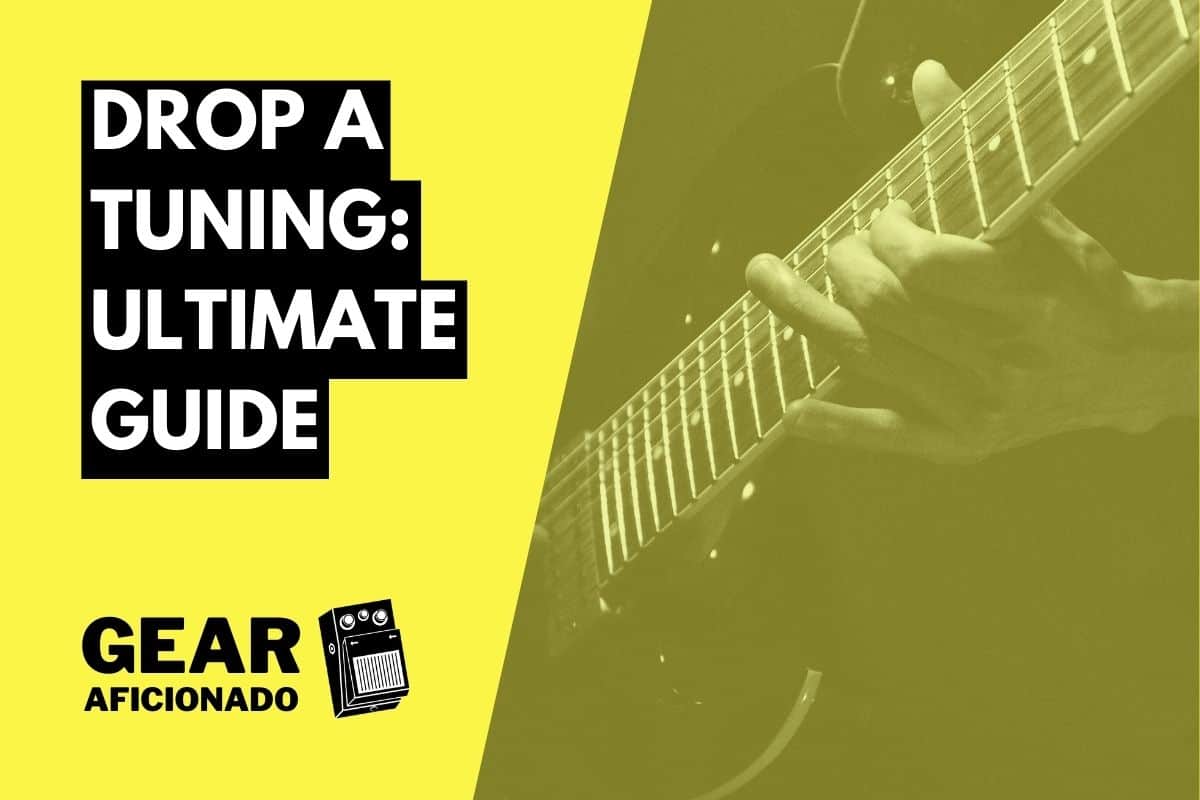Drop A tuning is a popular guitar tuning that is commonly used in heavy metal and hard rock music.
It involves tuning all six strings of the guitar down a perfect fourth from the standard E tuning and then tuning the low E string down an additional whole step.
This tuning produces a deep and heavy sound that is perfect for playing heavy riffs and power chords.
This tuning is often used by guitarists who want to create a darker and heavier sound.
It is a versatile tuning that can be used in a variety of musical genres, including metal, punk, and alternative rock.
With drop tunings, guitarists can achieve a heavier and more aggressive sound that is perfect for playing heavy riffs and power chords.
This is because they make playing power chords way easier by just barring the lowest 3 strings.
While drop tunning your guitar may seem intimidating to some guitarists, it is actually a relatively easy thing to learn.
With a little practice and patience, guitarists can quickly master this tuning and start playing their favorite heavy metal and hard rock songs.
Whether you are an experienced guitarist or a beginner, Drop A tuning is a great way to add some extra depth and power to your playing.
What is Drop A Tuning?
Drop A tuning is a type of guitar tuning that involves lowering the pitch of all six strings on a guitar.
This tuning is commonly used in heavy metal and other genres that require a lower, heavier sound.
In drop A tuning, the lowest string (the sixth string) is tuned down one whole step to A, while the other five strings are tuned down a perfect fourth from their standard tuning.
For example, in standard tuning, the strings are tuned to E, A, D, G, B, and E.
In Drop A tuning, the strings are tuned to A, E, A, D, F#, and B.
This creates a deep, heavy sound that is perfect for power chords and heavy riffs.
It is important to note that Drop A tuning will sound better with thicker strings than standard tuning.
This is because lower tunning put way less tension on the strings, so more massive ones will help compensate for the slackness and keep everything tight.
Guitarists who use Drop A tuning typically use string sets that are at least .012 to .056 in thickness.
Finally, you can also, and more easily, use the drop A tuning in 7-string guitars, by just lowering the low B string a whole tone to A.
Why Use Drop A Tuning?
Drop A tuning is a popular tuning for guitarists looking to extend the range of their instrument into a lower register.
The tuning allows players to lower the pitch of their guitar by a fourth, which is useful for playing heavy music genres such as metal and hard rock.
One of the main benefits of drop A tuning is that it makes it easier for players to change power chords in the lower register.
This is because, as I mentioned earlier, power chords in drop tunings take the shapes of barres in the lower strings, allowing you to play them using just one finger.
Another advantage of drop A tuning is that it can add a new dimension to a guitarist’s sound.
When you shift around things in the guitar, you are pushing yourself out of your comfort zone, and stop playing on autopilot.
This is great for massaging your creativity.
It can also make it easier to play certain riffs and licks that may be more difficult in standard tuning.
How to Tune Your Guitar to Drop A
Using a Tuner
The easiest and most accurate way to tune your guitar to Drop A is by using a tuner.
There are many different types of tuners available, including clip-on tuners, pedal tuners, and smartphone apps.
Regardless of what type of tuner you use, the process is generally the same:
- Turn on your tuner and select the Drop A tuning option.
- Play each string one at a time, starting with the lowest string (A).
- Adjust the tuning pegs, releasing the tension, until the tuner indicates that the string is in tune.
- Repeat this process for each string, moving from the lowest string to the highest string (B).
Once all of the strings are in tune, your guitar should be tuned to Drop A.
I would recommend repeating the process a few times since strings might not stay perfectly in place the first go around.
Tuning by Ear
If you don’t have a tuner, don’t worry, you can still tune your guitar to Drop A by ear.
This method may take a bit more time and practice, but it can be a useful skill to have.
The basic process for tuning by ear is as follows:
- Start by tuning your low E string down to A.
- You can do this by comparing the sound of the low E string to the open A string (5th string) on your guitar.
- Next, tune your A string down to E.
- To do this, compare the sound of the open A string to the seventh fret of the now low A (6th) string.
- Now, tune your D string down to A.
- To do this, compare the sound of the open D string to the open low A string (6th string). This one should be an octave higher than the reference. An alternative is using the 5th fret of the, now, E string above for the same pitch.
- Tune your G string down to D.
- To do this, compare the sound of the open G string to the fifth fret of the now A string (4th string).
- Tune your B string down to F#.
- To do this, compare the sound of the open B string to the fourth fret of the D string (3rd string).
- Finally, tune your high E string down to B.
- To do this, compare the sound of the open high E string to the fifth fret of the F# string.
Once all of the strings are in tune, your guitar should be tuned to Drop A.
Drop A Tuning Chords and Scales
Some popular chord shapes in Drop A tuning include the A minor, B minor, C major, and D major chords.
These chords can be played in various positions on the fretboard to create different voicings and sounds.
When it comes to scales, the Drop A tuning lends itself well to the A minor pentatonic and the A natural minor scales, taking advantage of the low A string commonly used as a pedal tone in metal.
These scales can be played in various positions on the fretboard to create different melodic patterns and solos.
Famous Songs in Drop A Tuning
Drop A tuning has been used by many famous bands and guitarists over the years.
Here are some of the most well-known songs played in Drop A tuning:
Jinjer – Pisces
Jinjer’s breakout hit, “Pisces,” showcases the versatility of Drop A tuning.
Slipknot – Psychosocial
Slipknot’s “Psychosocial” is another popular song played in this tuning, and the band’s use of drop tunings has inspired many heavy metal bands to follow suit.
Dragonforce – Three Hammers
Dragonforce’s “Three Hammers” also features Drop A tuning, although with a 7-string guitar, and showcases the band’s signature fast-paced guitar work.
Suicide Silence – You Only Live Once
Suicide Silence’s “You Only Live Once” is another well-known song played in this tuning.
Coheed and Cambria – Gravity’s Union
Coheed and Cambria’s “Gravity’s Union” adds an even heavier punch to their already aggressive sound with a drop tuning.
5 Tips for Playing in Drop A Tuning
Playing in Drop A tuning can be a fun and exciting way to explore new sounds on your guitar.
Here are a few tips to help you get started:
- Experiment with power chords: Drop A tuning is great for power chords, which are chords that consist of only the root note and the fifth.
- Try playing power chords on the lower strings to take advantage of the deeper, heavier sound.
- Practice alternate picking: Alternate picking is a technique where you pick the strings in a back-and-forth motion with your picking hand. This technique can help you play more accurately and with greater speed in Drop A tuning.
- Use palm muting: Palm muting is a technique where you lightly rest the side of your picking hand on the strings near the bridge of the guitar. This can help you create a tighter, more controlled sound when playing in Drop A tuning.
- Take advantage of the barre power chords in the lowest string, but don’t forget to combine them with regular-shaped power chords in the higher strings.
Additionally, it’s important to keep in mind that such a low drop tuning will greatly lower the tension of your strings if you don’t go for a heavier gauge, causing intonation problems.
Conclusion
Drop A tuning is a great way to explore new sounds and styles on the guitar.
It is a popular tuning for heavy metal and other genres that require a thick, heavy sound.
However, it is important to note that Drop A tuning can be challenging for beginners and may require adjustments to your playing style.
When experimenting with Drop A tuning, I’d recommend you have a good understanding of the tuning, how it affects your playing, and its difference from standard tunings.
It is also important to have the right equipment, a guitar with a longer scale length and thicker strings will help make it all sound more “put together”.
Ultimately, the best way to learn Drop A tuning is to practice and experiment with different techniques and styles.
With time and dedication, you can master this tuning and unlock a new world of possibilities on the guitar.

Hello there, my name is Ramiro and I’ve been playing guitar for almost 20 years. I’m obsessed with everything gear-related and I thought it might be worth sharing it. From guitars, pedals, amps, and synths to studio gear and production tips, I hope you find what I post here useful, and I’ll try my best to keep it entertaining also.





